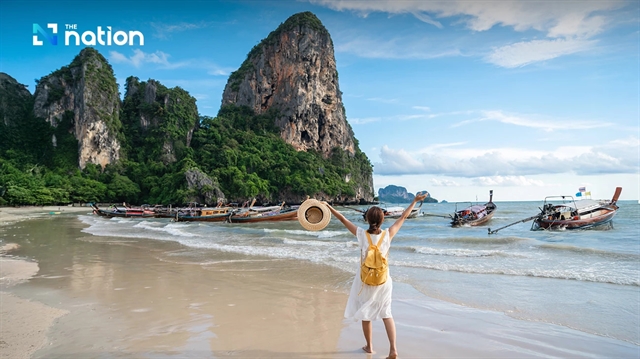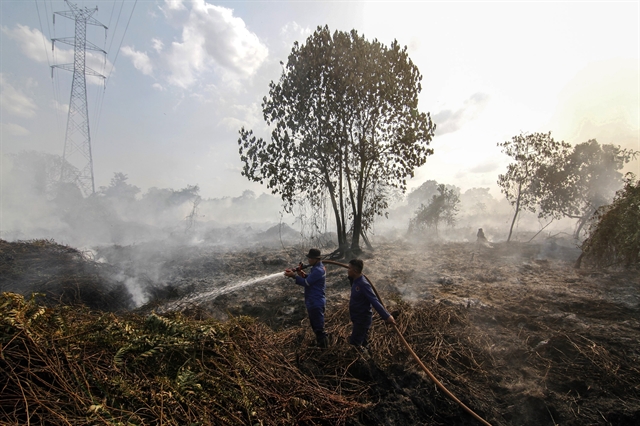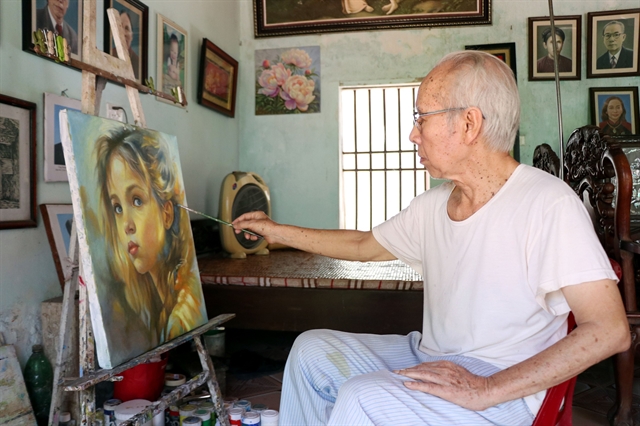 Features
Features
.jpg)
Sơn Đoòng, the world's largest cave, caught our attention about 10 years ago. When magnificent photos of the cave were taken by members of the British Caving Association and other visitors, I felt great pride as a Vietnamese.

|
| TEAM WORK: Connected by a rope, the group crosses many lakes and rivers inside Sơn Đoòng. All photos courtesy of Nguyễn Hoài Châu |
by Nguyễn Hoài Châu
Sơn Đoòng, the world's largest cave, caught our attention about 10 years ago. When magnificent photos of the cave were taken by members of the British Caving Association and other visitors, I felt great pride as a Vietnamese.
But in the back of my mind, I thought it was only for international tourists used to planning their travel a couple of years ahead or spending US$3,000 for a trip of only a few days and who had trained themselves to be disciplined in cycling, running and swimming as a daily exercise several months before the trip.
The Sơn Đoòng tour is open from January until the end of August, with a maximum of 100 groups, with 1,000 guests as the total limit.
Two years ago, we took a trip to Tú Làn cave. Ten women in their 40s in their prime time of life and working career decided to sign up and make a group for a memorable and affordable trip.
We instantly fell in love with the pristine and charming beauty of the cave. We were challenged by the rough slopes and water-filled caves, not to mention being blown away by waking in the beautiful green shade of the jungle.
We had seen how wonderful Tú Làn was, and we knew we had to experience the magnificence of Sơn Đoòng. The day our trip to Tú Làn was completed was the day we decided to sign up for Sơn Đoòng, whatever the cost.
COVID break
The pandemic struck suddenly, borders shut down, international explorers cancelled their trips, and Oxalis adventure travel agency announced a 20 per cent discount to all Vietnamese travellers. It was less difficult to book, and the costs became much less expensive, but our worries about our physical abilities remained.
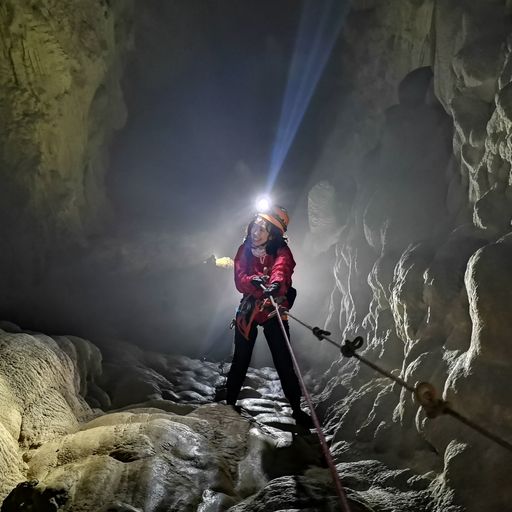
|
| HEART OF DARKNESS: Exploring Sơn Đoòng can be physically challenging, having the skills to use rope for climbing is a plus point. |
I've hardly exercised in my life. How could I climb the 100m tall Wall of Việt Nam? Would I be able to belay and rappel down a 200m doline? Would I survive the sheer physical and mental exertion?
Nevertheless, I held on to my belief that I would be able to accomplish it. I have climbed the 18km unbeaten rocky path to A Pa Chải, a tri-border area where folks from Việt Nam, Laos and China can hear a rooster announcing the new day, as there is not even an access road.
I've climbed the risky Cửa Tử (Gate of Death) in Thái Nguyên Province. I've climbed and walked Winikunka at 5,036m above sea level to the summit of the Rainbow Mountain in Peru. Then there was Tú Làn, of course. So why not have a crack at the largest cave in the world?
I called three other travel companions I thought were the most daring and risk-taking people I knew. We agreed on a date in May 2021.
But the pandemic tested our patience. Two weeks before our departure, the fourth wave of COVID hit Việt Nam. I vividly remember April 28, and the first serious positive case. And the numbers multiplied after the May 1, Labour Day holiday. But we thought we could stick to our plan, as there would be no virus inside the cave.
But it was getting worse and more stressful closer to our departure date: new cases increased rapidly, and there was no vaccine to take. Each family stayed quarantined at home, and our flights to Quảng Bình were cancelled. Just a few days were left before the date, and we had to make the hard decision to delay our trip to a later time, awaiting developments of the pandemic that seemed to be ravaging the country.
It was a painful year. Many people died. Families had to quarantine or go to the hospital. The tourism sector suffered hard and was completely paralysed. We wondered if the trip would ever happen.
It took almost a year for life to slowly get its rhythm back, and the first trips to Sơn Đoòng could resume. On March 15, when we were already exploring the cave, Việt Nam announced it would reopen its doors to tourists.
The first and foremost assignment we gave ourselves was not to exercise or train to be more physically adaptable but not get COVID before our trip. It was hard, as the country was vaccinated, so positive people with no symptoms could be sitting next to you in your office, or one of your kids could easily bring it home from school.
Sure enough, three of our four registered for the trip became infected with the virus. Two recovered 10 days before the trip. One tested positive at the last minute, so after delaying for one year and recovering from COVID, three of us could finally take the journey of our dreams, having to leave one behind.
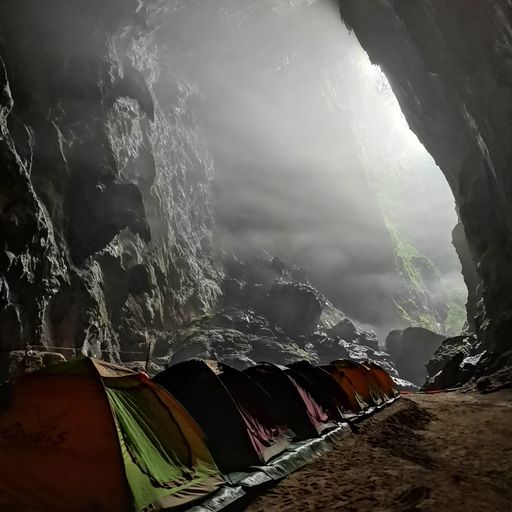
|
| CAVE CAMP: Tents for explorers to spend the night must be set up by the pros, under shining light from the doline nearby. |
The dream trip
The trip to Sơn Đoòng used to take five to six days a few years back, with the sixth day being the hardest. Once Oxalis found a way to safely get tourists to climb the 100m high Wall of Việt Nam, the actual trip was reduced to only four days and three nights inside the cave.
Three of us teamed up with seven others to make our group. They overwhelmed us with their sporting achievements: iron men and women that loved swimming, running and cycling, those that ran a 55-km marathon in a good time. The three of us had few sporting achievements and didn't train before this trip, so we were full of worry.
We were put at ease after seeing the bright banana green shirts of the supporting team that would accompany us to the cave and back: 28 young pro porters, assistants and cooks, topped with Adam Spillane, one of the original Sơn Đoòng exploring team from the UK. He would make sure we all stayed safe during our trip.
It was announced he would observe and decide after the first day if anyone was unfit for the journey. We approached him: "Please do not discard us from this trip!"
"I never exclude anyone. They give up and want to stay back," he replied.
Spillane told us that he had been in Việt Nam for 17 years and never felt bored with the caves.
On the first day, we had to go to Hang Én (Swallow cave) to pass it to get to Sơn Đoòng. The walk was relatively smooth and easy. We occasionally suspiciously looked at each other in disbelief. Sơn Đoòng could not be this easy.
The only annoying factor was the constant leeches. On the path that led to the cave entrance, we saw a beautiful lake down by the cave. Its sand was smooth. It made a perfect beach, lit by the mouth of the cave.
After an icy cold swim in the lake, we awaited a hot steam sauna in our tent. Then a hot dinner was made for our group until we were all content to don our best 'evening wear' to take a memorable photo set against the lake. If we uploaded these photos to the internet, surely no one would believe that we were on a cave exploration of the highest difficulty.
A sound night's sleep prepared us for the next day, which would be supremely tough. We all had to wear helmets with lights on like miners, caving gloves to climb and walk or even crawl with utmost care. The mountain was high, with steep, wet slopes, and the cave was in complete darkness. The lighting on our foreheads was the sole source of guidance. One slipped step or mishandling, and we would be in deep trouble.
We had a brief lunch and then put on our safety kits to get ready to lower down the first great doline. The only thing we had to grip was the hanging rope. It was a nerve-wracking experience as you only had the rope to hold, the stone wall was stiff, you could not find a place to put your feet, and all below was an empty deep darkness. You could not see anything, and your arms became painful and exhausted. I wanted to give up. I wanted to let go and call for someone to come and pick us up.
Nevertheless, you have to move on, and the encouragement from the assistants and porters was a godsend. I tried slowly, bit by bit, until finally, I could touch the ground.
We then crawled on the surface and crossed a belly-level lake to get to our campsite. The first doline let in a giant flow of light from above, illuminating the whole area where we stayed. We had a five-minute rest and then swam in our own hiking clothes. Another 60m crawl, and we got to a natural pool between two harsh cliffs.
The water was emerald and crystal clear. It was so inviting that we told ourselves we had to jump into this beautiful pool. Our first foot into the icy cold water gave us a quick shock, and slowly we immersed ourselves into the cold water that froze our senses and muscles.
But suddenly, we didn't feel cold at all, but nothing other than a deep sense of satisfaction that we had overcome our fears to dive deep into the great gifts of nature.
Once again, we returned to a fragrant hot sauna at the campsite. The intense fatigue and exhaustion had all but gone and were replaced by a feeling of being recharged and inspired.
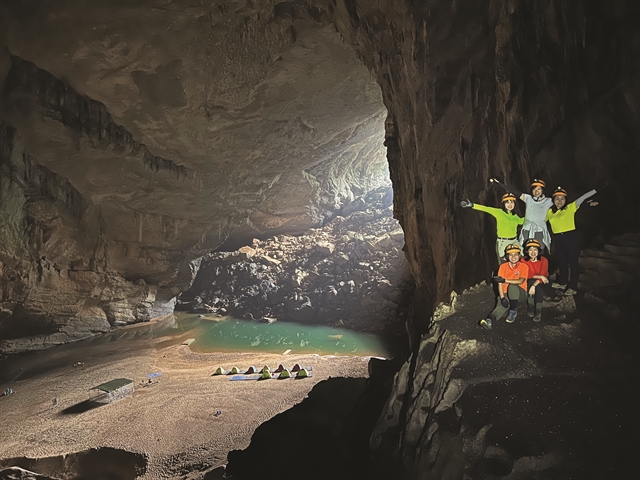
|
| NATURAL WONDER: A beach with fine sand by a lake inside the world's largest cave. |
The next day, our guide told us to wear our best clothes as it would be the signature day of the trip. After a long hike and much crawling, we got to the first doline where a circle of 150m in diameter of the roof had collapsed, at a distance 400m higher than our campsite.
When we got here, we saw the many cave systems inside the larger Sơn Đoòng area. Light from the doline naturally lit the cave up.
A small mountain standing right underneath the doline grabbed my attention. It reminded me of the spiral citadel of Cổ Loa in history, but was known by a different name: the Wedding Cake.
The Wedding Cake has become the signature image for anyone taking the Sơn Đoòng trip, and all want to take a picture on top of it.
Descending the cake, we further explored the dark caves. When we got out to a broader area, the slanted lighting and diverse sizes and shapes of the stalagmites, and the crystal clear pond reflections made the whole area appear like a natural stage.
We then scattered our lunch boxes on the stones around the stage and ate with our eyes entertained with the best view you could possibly imagine.
Another long hike brought us out to the Paradise Garden at Doline 2 area. A circle of 230m-diameter on the ceiling has collapsed, letting rain and light come down from above, nurturing a sizeable green bed of flora. Right next to it, the dark cave has some sand dunes, with explorers walking on them. It reminded me of a desert in Iran or somewhere in Africa.
When we got to the campsite, our guide told us to get ready for swimming again.
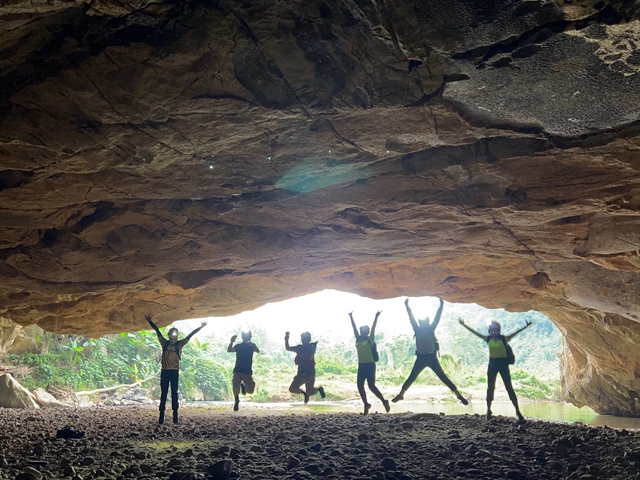
|
| CONQUERERS: After long walks and much swimming in icy cold water, the team have joyful moments to cheer them up, and take a memorable photo to bring home. |
The Wall of Việt Nam
The Wall was to be our last day's challenge, where we would have to climb up the 100m tall wall. The morning sunbeams woke us up, reflecting from the cave gate. We then got ready, put the heavy safety kit on and started walking toward the wall in the quiet and darkness of the cave.
Ahead of us were nothing more than mounds and mountains of mud with water running from them. The water was not enough to use a raft, and the only way we could manage was to walk along these muddy mountains, hands holding on to the mud on both sides and carefully not letting our feet and shoes get stuck in the mud as best we could.
Wading through the water up to our calves or above our knees, we tried not to juggle in the mud as the more we moved, the deeper we became stuck. The path was so long, that it seemed never-ending, and maybe after 2km we got to the Wall.
There was nothing like a regular wall about it. It felt more like a tall mountain, so high we couldn't see anything above or beyond it. At the foot of the Wall, the stone was carved inside to form an arch, and by just looking, we knew we might never get over this mighty beast.
Our climbing gear needed to be installed right there: an 18-m ladder was set up so that we could climb up to the mountain and then keep going over it. Each person needed 7 minutes to climb up, and again, we were the last to take the challenge. We waited for nearly an hour, standing in the mud, listening to water dropping, in coldness and fear.
When I got to the top of the ladder, I started to feel dizzy, my breathing was hard, and my fear of altitude overwhelmed me. I had only finished one-fifth and easiest part of the path. In front of me was a straight cliff with slippery stone and nowhere to put my feet. I saw two ropes in front and a vague image of the guide ahead calling on. Clasping the safety hook on one rope, the other was for me to hold on to climb up.
I remembered all the directions by heart: two hands holding on to the rope, bend your body to 45 degrees to the cliff, push both feet against the stone and move. But I couldn't tell my body to move according to the instructions. I was overwhelmed with fear: fear of free-falling down from where I was standing, fear that if I stretched my legs, I would not be able to hold on to the cliff or that my fingers would slip from the only rope.
I couldn't tell my legs to push, and I only used my arms to pull myself up. After 20m or so, my hands were so worn out, my feet could not push onto the stone, and my body turned around, banging my butt against the cliff. The safety hook prevented me from free-falling.
Then the guide from the top moved down to grab my hands, the other guide from the back pushed me up, and I got to the stop in the middle, getting my footrest and dabbing my face on the cliff without looking down to help me from feeling dizzy.
"Please let me take a long break," I begged the guide.
"Take as long as you want," he said. "The hike above won't be as hard. Your friend already made it. Don't worry."
My arm muscles had worked too hard and turned stiff. I had to hold my fist and release it for a while to make them have feeling again because they would be the only force to pull me up the rest of the wall.
The guide hadn't lied. The stone became less hard, and in no time, I didn't know what force had pushed me up, and all of a sudden, I saw a flickering light at the other end of the dark tunnel.
When I arrived at the end, there was much-needed hot soup and crispy bread ready to warm me up.
On the last leg of the trip, a three-hour trek in the forest with scattered falling down a slippery path, I started to regret that our journey would end soon. I was sad to leave everything behind, even though my body was so exhausted I didn't want to move, and my mouth could not utter a word. My last steps were out of the forest toward where the Sơn Đoòng medals were awaiting, with the assistants and guides who had helped us so much waving us on.
As we received our medals among the cheers and clapping of our teammates, we toasted ice-cold beers with all of the crew and felt on top of the world as we had conquered Sơn Đoòng, but we also felt a certain sadness to be leaving our new companions.
No words can describe the magnificent beauty of the caves, and no video footage can capture the beauty of nature, the deep darkness of the underground tunnel or the smell of untouched forest inside this world's largest cave.
Maybe the Oxalis motto helps me say it better, “Dream it, Believe it, Achieve it”. And, that's exactly what we did. VNS
.jpg)
